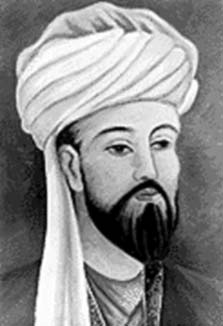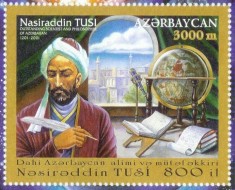| Nasir al-Din al-Tusi | |
|---|---|
 |
|
| Polymath | |
| Specialty | Astronomy, mathematics, architecture, biology, chemistry, philosophy, medicine, physics, science, theology |
| Born | Feb. 18, 1201 (Jamadi al-Ula 11, 597) |
| Died | June 26, 1274 (at age 73) (Dhu’l-Hijjah 18, 672) |
| Nationality | Persian |
Born Khawaja Muhammad ibn Muhammad ibn Hasan Tusi on February 18, 1201, in Tus, Greater Khorasan (in northeastern Persia), Nasir al-Din al-Tusi was one of the most prominent Persian Muslim scholars; he was an astronomer, chemist, mathematician, philosopher, physicist, architect, theologian and physician.
Early Years of al-Tusi
The famous 13th century erudite scholar grew up in Tus and continued his education 50 miles to the west, in Neyshabur, where he studied philosophy and then in Mosul, where he studied astronomy and mathematics. This relocation was quite auspicious, considering the fact that Genghis Khan aimed at conquering the Islamic world as well and by 1220, his army had already reached his native town.
He studied philosophy In 1227, and eventually he found refuge in the mountain fortress belonging to the Ismailite governor Nasir al-Din Abd al-Rahim, to whom he dedicated his 1232 famous work entitled Nasirean Ethics. During the time spent in the Alamut castle, one of the two important Ismailite citadels, he wrote many of his most significant scientific works.
After the invasion of Alamut by the forces of Hulegu Khan in 1256, al-Tusi accepted to serve as scientific advisor and eventually married a Mongol, leading to allegations that his conversion to the Ismailite religion was fake. He was also appointed as head of the ministry of religious bequests and although it remains controversial whether he accompanied the Mongol troops in their attempt to take over Baghdad in 1258 but he did visit the Shi ite centers after the conquest.
In 1259, he persuaded Hulegu Khan (who believed strongly in astrology) to financially support the construction of the most advanced observatory, the Rasad Khaneh Observatory (located in Maragheh, in present-day Azerbaijan), which was enhanced with a large library and where research continued after al-Tusi s death.
Mathematics and Religion
 In the medieval Islam world, he is considered as the most prolific author of the Islamic Golden Age, having written more than 150 books in both Arabic and Persian on a large number of subject areas, including the Islamic religion. The Arabic versions of the works of ancient scholars such as Archimedes, Euclid, and Ptolemy are among his most notable works.
In the medieval Islam world, he is considered as the most prolific author of the Islamic Golden Age, having written more than 150 books in both Arabic and Persian on a large number of subject areas, including the Islamic religion. The Arabic versions of the works of ancient scholars such as Archimedes, Euclid, and Ptolemy are among his most notable works.
The famous Persian polymath is regarded in the East as a “hakim” (wise man) and he is specially known for his significant contribution to the evolution theory and to the development of astronomy and mathematics, trigonometry in particular. He was the first scientist to write a work which was entitled Treatise of the Quadrilateral which described spherical trigonometry independently from astronomy. Thanks to his works, trigonometry became an independent branch of mathematics and thus distinct from astronomy.
Contributions to Astronomy
Al-Tusi’s original contribution to astronomy consists primarily in inventing a geometrical technique named the Tusi-couple (a term coined in 1966 by Edward Kennedy) and it was originally intended to be a solution for the study of the latitudinal motion of the inferior planets.
Later on, this mathematical device (which consists in a small circle that rotates inside a larger circle, whose diameter is twice the diameter of the small circle) was used to substitute Ptolemy’s equant (developed in the 2nd century). These rotations determine a point located on the circumference of the smaller circle to oscillate in linear motion along the diameter of the bigger circle. Al-Tusi’s 1247 groundbreaking invention was used by Nicolaus Copernicus ( 1473-1543) in a work entitled De Revolutionibus in which he reformulated mathematical astronomy.
His most famous work in the West is entitled Treasury of Astronomy and it describes the breakthrough invention known today as the aforementioned Tusi-couple. Ilkhan Tables is another significant work by al-Tusi. It was completed in 1972 and it represents a collection of accurate tables presenting the planetary movements, based on his extensive research at the Maragheh observatory.
Al-Tusi’s Legacy and Death
Al-Tusi’s model for the planetary system was extensively used until the development of the heliocentric Copernican model. Al-Tusi’s contribution to astronomy included also the construction of astronomical instruments such as the astrolabe, which was used in the Islamic world to calculate the Quibla and to find the right time for Salat.
Al-Tusi was also the first astronomer to state that the Milky Way was composed of an extremely large number of small and clustered stars, a scientific fact which was proven in 1610 by Galileo Galilei using a telescope.
Nasir al-Din al-Tusi passed away at the age of 73, on June 26, 1274, in Baghdad.